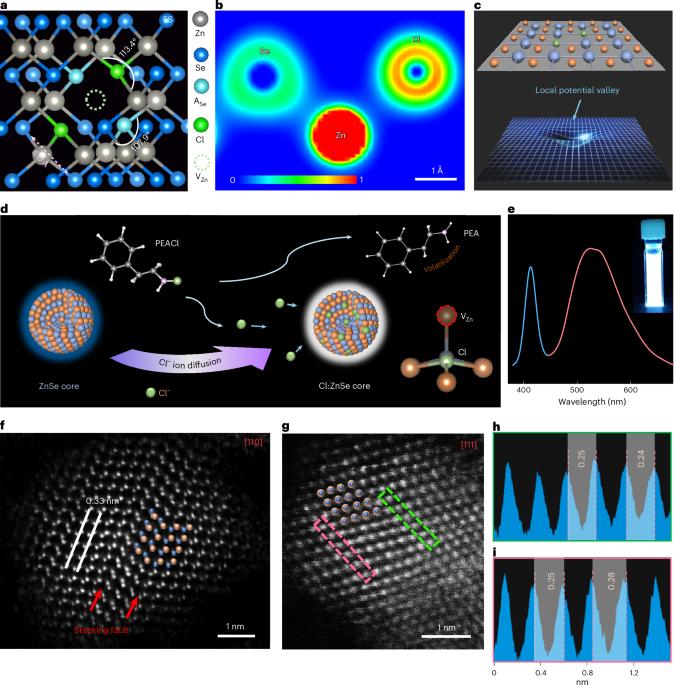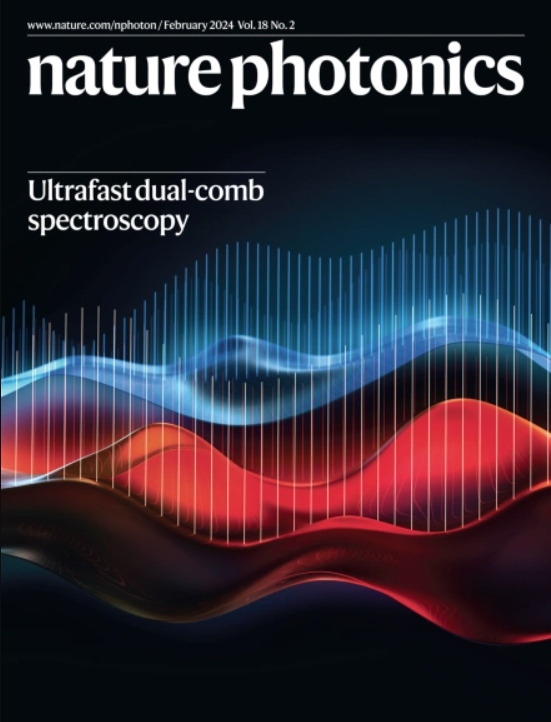Local lattice softening in semiconductor quantum dots for efficient white light-emitting diodes
IF 32.9
1区 物理与天体物理
Q1 OPTICS
引用次数: 0
Abstract
White light-emitting diodes based on single-component quantum dots (sc-WQLEDs) have gained great attention owing to their low operating voltage and the high spectral stability of their emission. However, their performance presently lags far behind that of state-of-the-art white organic LEDs owing to a lack of efficient white quantum dot emitters. Creating self-trapped excitons in semiconductor quantum dots is a promising approach to producing broadband white emission. However, such emitters generally suffer from poor charge transport and structural instability. Here we accomplish controllable synthesis of core/shell structured ZnSe/ZnS quantum dots with efficient white emission through combining a sharp excitonic blue emission with a broadband yellow self-trapped exciton emission owing to local lattice softening of ZnSe cores by heterovalent doping with halogen ions. We reveal that the self-trapped excitons confined in the surrounding ZnSe covalent-bond matrix can generate strong and stable yellow emission with minimal reduction of the excitonic blue emission and charge transport capability of ZnSe. On the basis of this approach, we demonstrate highly efficient, heavy-metal-free WQLEDs with a maximum external quantum efficiency up to 15% (average 10.5 ± 2.6%), a luminance of over 26,000 cd m−2 as well as exceptional device operational lifetime with T50 exceeding 2,500 h at an initial luminance of 100 cd m−2. Semiconductor quantum dots that simultaneously support blue and yellow emission offer a route to realizing efficient white light-emitting diodes.


高效白光发光二极管用半导体量子点的局部点阵软化
基于单组分量子点的白光发光二极管(sc- wqled)由于其低工作电压和高光谱稳定性而受到广泛关注。然而,由于缺乏高效的白色量子点发射器,它们的性能目前远远落后于最先进的白色有机led。在半导体量子点中产生自困激子是一种很有前途的产生宽带白光的方法。然而,这种发射体通常存在电荷输运差和结构不稳定的问题。本研究通过杂价掺杂卤素离子使ZnSe核的局部晶格软化,将尖锐的激子蓝色发射与宽带自捕获的黄色激子发射相结合,实现了具有高效白光发射的核/壳结构ZnSe/ZnS量子点的可控合成。我们发现,束缚在周围ZnSe共价矩阵中的自捕获激子可以产生强而稳定的黄色发射,而ZnSe的激子蓝色发射和电荷输运能力却最小。在此方法的基础上,我们展示了高效,无重金属的wqled,其最大外部量子效率高达15%(平均10.5±2.6%),亮度超过26,000 cd m−2,以及在初始亮度为100 cd m−2时T50超过2,500 h的特殊器件工作寿命。
本文章由计算机程序翻译,如有差异,请以英文原文为准。
求助全文
约1分钟内获得全文
求助全文
来源期刊

Nature Photonics
物理-光学
CiteScore
54.20
自引率
1.70%
发文量
158
审稿时长
12 months
期刊介绍:
Nature Photonics is a monthly journal dedicated to the scientific study and application of light, known as Photonics. It publishes top-quality, peer-reviewed research across all areas of light generation, manipulation, and detection.
The journal encompasses research into the fundamental properties of light and its interactions with matter, as well as the latest developments in optoelectronic devices and emerging photonics applications. Topics covered include lasers, LEDs, imaging, detectors, optoelectronic devices, quantum optics, biophotonics, optical data storage, spectroscopy, fiber optics, solar energy, displays, terahertz technology, nonlinear optics, plasmonics, nanophotonics, and X-rays.
In addition to research papers and review articles summarizing scientific findings in optoelectronics, Nature Photonics also features News and Views pieces and research highlights. It uniquely includes articles on the business aspects of the industry, such as technology commercialization and market analysis, offering a comprehensive perspective on the field.
 求助内容:
求助内容: 应助结果提醒方式:
应助结果提醒方式:


